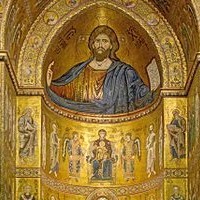Home - In and around
The Palatine Chapel, a three-aisled basilica dedicated to Saints Peter and Paul. It was built at the behest of Roger II and was consecrated April 28, 1140 as a church of the royal family. Damaged by the earthquake of September 2002 it underwent restoration, completed in July 2008.
The dome, the transept and apses are entirely decorated at the top with Byzantine mosaics, among the most important in Sicily, depicting Christ Pantocrator blessing, the evangelists and various biblical scenes. The oldest dating mosaics are those of the dome, dating back to the original construction of 1143. Next to the Christ Pantocrator are angels, archangels, prophets, saints, evangelists; on the chancel arch, the Annunciation and the Presentation in the Temple; in the apse, Christ blessing.
A later period (about 1154-66) are the mosaics with Latin inscriptions that decorate the nave, representing stories of the Old Testament; later still those of the aisles, with stories of St. Peter and St. Paul. At the beginning of the nave, the vast royal throne, encrusted with mosaics; near the shrine, right, a rich mosaic ambo, supported by fluted columns, and a superb Easter candelabrum (high m. 4:50), carved acanthus folglie, figures and animals: they are works of the twelfth century with the fusion of Romanesque elements, Arabs and Byzantines. [9] The wooden ceiling of the nave and the beams of the other aisles are decorated with carvings and paintings of Arabic style. In each segment there are wooden stars with representations of animals, dancers and scenes of the Islamic court life.
The ceiling is coffered and muqarnas of about 1143 and has, in addition to paintings, inscriptions in Kufic.
source wiki
PALATINE CHAPEL PALERMO
The Palatine Chapel, a three-aisled basilica dedicated to Saints Peter and Paul. It was built at the behest of Roger II and was consecrated April 28, 1140 as a church of the royal family. Damaged by the earthquake of September 2002 it underwent restoration, completed in July 2008.
The dome, the transept and apses are entirely decorated at the top with Byzantine mosaics, among the most important in Sicily, depicting Christ Pantocrator blessing, the evangelists and various biblical scenes. The oldest dating mosaics are those of the dome, dating back to the original construction of 1143. Next to the Christ Pantocrator are angels, archangels, prophets, saints, evangelists; on the chancel arch, the Annunciation and the Presentation in the Temple; in the apse, Christ blessing.
A later period (about 1154-66) are the mosaics with Latin inscriptions that decorate the nave, representing stories of the Old Testament; later still those of the aisles, with stories of St. Peter and St. Paul. At the beginning of the nave, the vast royal throne, encrusted with mosaics; near the shrine, right, a rich mosaic ambo, supported by fluted columns, and a superb Easter candelabrum (high m. 4:50), carved acanthus folglie, figures and animals: they are works of the twelfth century with the fusion of Romanesque elements, Arabs and Byzantines. [9] The wooden ceiling of the nave and the beams of the other aisles are decorated with carvings and paintings of Arabic style. In each segment there are wooden stars with representations of animals, dancers and scenes of the Islamic court life.
The ceiling is coffered and muqarnas of about 1143 and has, in addition to paintings, inscriptions in Kufic.
source wiki



